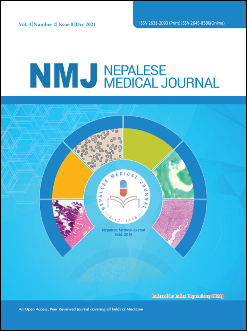Histopathological Spectrum of Non-neoplastic and Neoplastic Lesions of Urinary Bladder
DOI:
https://doi.org/10.3126/nmj.v4i2.41353Keywords:
Carcinoma, Cystectomy, Cysto, Urinary bladderAbstract
Introduction: Urinary bladder is a site of various non-neoplastic and neoplastic lesions, both of which can present with hematuria. Cystoscopy allows for direct visualization of the bladder mucosa and also obtaining tissue for histopathologic evaluation. The most common non-neoplastic and neoplastic lesion of the urinary bladder is non-specific cystitis and urothelial carcinoma respectively.
Materials and methods: This study is a 4-year retrospective study conducted in the Department of Pathology at Patan Hospital, Nepal. All cases from the urinary bladder i.e., both cystoscopic and cystectomy samples were included in the study. Hematoxylin and eosin-stained slides were re-evaluated whenever required.
Results: A total of 145 cases were included which consisted of 17 cystectomy specimens and 128 cystoscopic biopsies. There was a male predominance. The non-neoplastic and neoplastic cases consisted of 32% and 68% respectively. Chronic non-specific cystitis and high-grade infiltrating urothelial carcinoma were the most common non-neoplastic and neoplastic lesions respectively. 56.1% of cystoscopic biopsies had the presence of detrusor muscle with 21.7% showing its invasion.
Conclusions: Urinary bladder lesions have a wide spectrum ranging from non-neoplastic to neoplastic conditions. The presence of detrusor muscle in a cystoscopic biopsy, and its evaluation for invasion helps in diagnosis and further planning of patient management.
Downloads
Downloads
Published
How to Cite
Issue
Section
License
Copyright (c) 2021 Manisha Shrestha, Dipti Gautam, Prakriti Shah, Prateek Krishna Shrestha

This work is licensed under a Creative Commons Attribution 4.0 International License.
This license enables reusers to distribute, remix, adapt, and build upon the material in any medium or format, so long as attribution is given to the creator. The license allows for commercial use.
Copyright on any article published by Nepalese Medical Journal is retained by the author(s).
Authors grant Nepalese Medical Journal a license to publish the article and identify itself as the original publisher.
Authors also grant any third party the right to use the article freely as long as its integrity is maintained and its original authors, citation details and publisher are identified.




